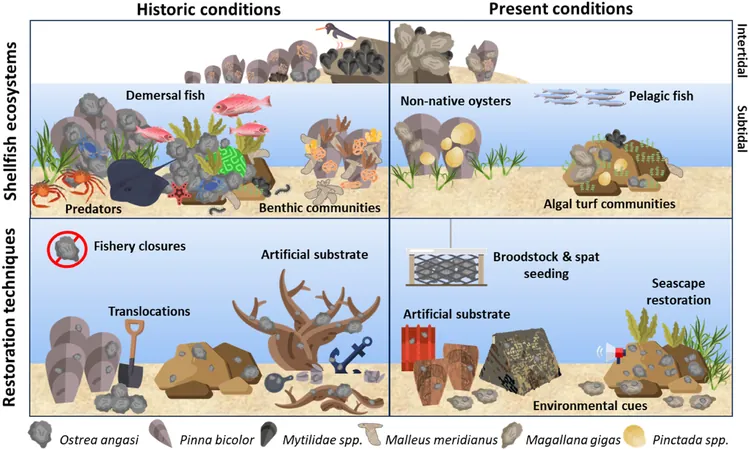
The Urgent Need for Shellfish Reef Restoration: Can We Save Our Ocean’s Hidden Treasures?
2025-01-23
Author: Nur
The Silent Tragedy of Shellfish Reefs
As you dive into a plate of fresh Pacific oysters or fire up the barbecue with seafood delights this weekend, take a moment to reflect on the silent tragedy of our local shellfish reefs. Unfortunately, most of these once-thriving ecosystems have been lost or neglected, as South Australian marine biology experts from Flinders University caution.
The Pressing Need for Restoration
With shellfish reefs being among the most severely affected coastal ecosystems, the need for coastal management and reef restoration has never been more pressing. The researchers emphasize that while we enter the United Nations Decade on Ecosystem Restoration, the alarming global decline of shellfish systems—up to 85% of oyster reefs—shows no signs of improvement, and South Australia is facing a similar fate.
Research Initiatives
Brad Martin, a Ph.D. candidate at Flinders, leads a ground-breaking research initiative that combs through centuries of records showcasing South Australia’s shellfish management history. This in-depth analysis reveals crucial insights into past reef ecosystems and offers guidance on restoring current shellfish reefs.
Community Engagement
Martin remarks, “By understanding the historical context and ecological dynamics, we can develop robust conservation strategies that involve community engagement and stakeholder support.” Recent efforts to restore shellfish reefs are gaining traction, thanks to heightened awareness of their critical ecological roles.
Historical Loss and Current Efforts
The research identified over 140 locations where shellfish reefs once flourished, spanning approximately 2,630 square kilometers of South Australian coastal waters, including around 887 square kilometers designated as former native oyster reefs and coral oyster habitats. Disturbingly, most of these ecosystems no longer exist.
Since the 1840s, commercial harvesting has decimated local oyster populations; by the 1910s, over 43 million oysters had been harvested. This unsustainable demand prompted the introduction of early fisheries laws and marine conservation efforts, including the establishment of fishery closures and marine reserves.
Successful Restoration Models
Martin highlights, “Successful oyster reef restoration has historically taken place in Port Lincoln and Kangaroo Island, showcasing community awareness and proactive measures against shellfish reef degradation.” These historical successes serve as important lessons for contemporary restoration initiatives.
Community-Driven Projects
Community-driven projects like the Port River shellfish reef restoration, the Flinders University Citizen Science Reef on Kangaroo Island, and the Coffin Bay citizen science oyster reef project are leading the charge in revitalizing native oyster and razorfish populations for future sustainability. The public can also contribute by reporting sightings of existing shellfish ecosystems through platforms like iNaturalist or the Atlas of Living Australia.
Challenges Ahead
Tragically, despite various legislative and restoration efforts over the past 200 years, historical records indicate that destructive fishing practices, mismanagement of marine resources, and environmental stressors such as droughts and diseases have eroded these vital habitats.
The Importance of Razor Clams
The research reveals that razor clams or ‘razorfish’ (Pinna bicolor) played a critical role in establishing these diverse ecosystems, providing essential surfaces for oyster colonies to thrive. While communities work tirelessly to restore these reefs, data indicates that razor clams, hammer oysters, and native mussels remain largely understudied and faced with decline.
A Call to Action
According to Dr. Ryan Baring, a senior author on the study, “The focus has been predominantly on commercially popular species, while the conservation status of lesser-known shellfish ecosystems is sadly overshadowed.”
With concerted efforts and community involvement, the revival of South Australia’s native shellfish ecosystems is possible. Now, the question is: Will we take action before it's too late? Join the movement and play a part in preserving these ocean gems!





 Brasil (PT)
Brasil (PT)
 Canada (EN)
Canada (EN)
 Chile (ES)
Chile (ES)
 Česko (CS)
Česko (CS)
 대한민국 (KO)
대한민국 (KO)
 España (ES)
España (ES)
 France (FR)
France (FR)
 Hong Kong (EN)
Hong Kong (EN)
 Italia (IT)
Italia (IT)
 日本 (JA)
日本 (JA)
 Magyarország (HU)
Magyarország (HU)
 Norge (NO)
Norge (NO)
 Polska (PL)
Polska (PL)
 Schweiz (DE)
Schweiz (DE)
 Singapore (EN)
Singapore (EN)
 Sverige (SV)
Sverige (SV)
 Suomi (FI)
Suomi (FI)
 Türkiye (TR)
Türkiye (TR)
 الإمارات العربية المتحدة (AR)
الإمارات العربية المتحدة (AR)